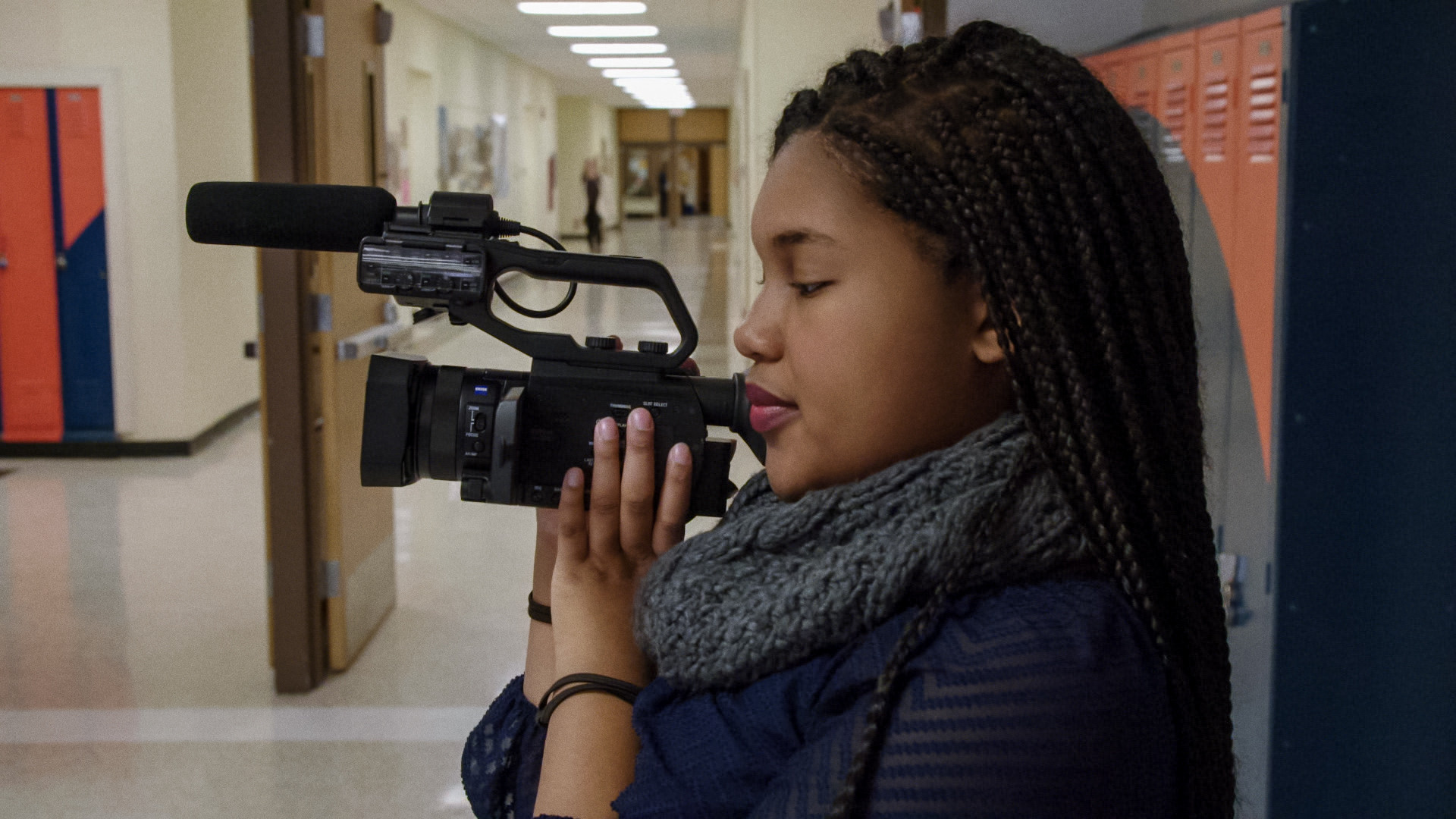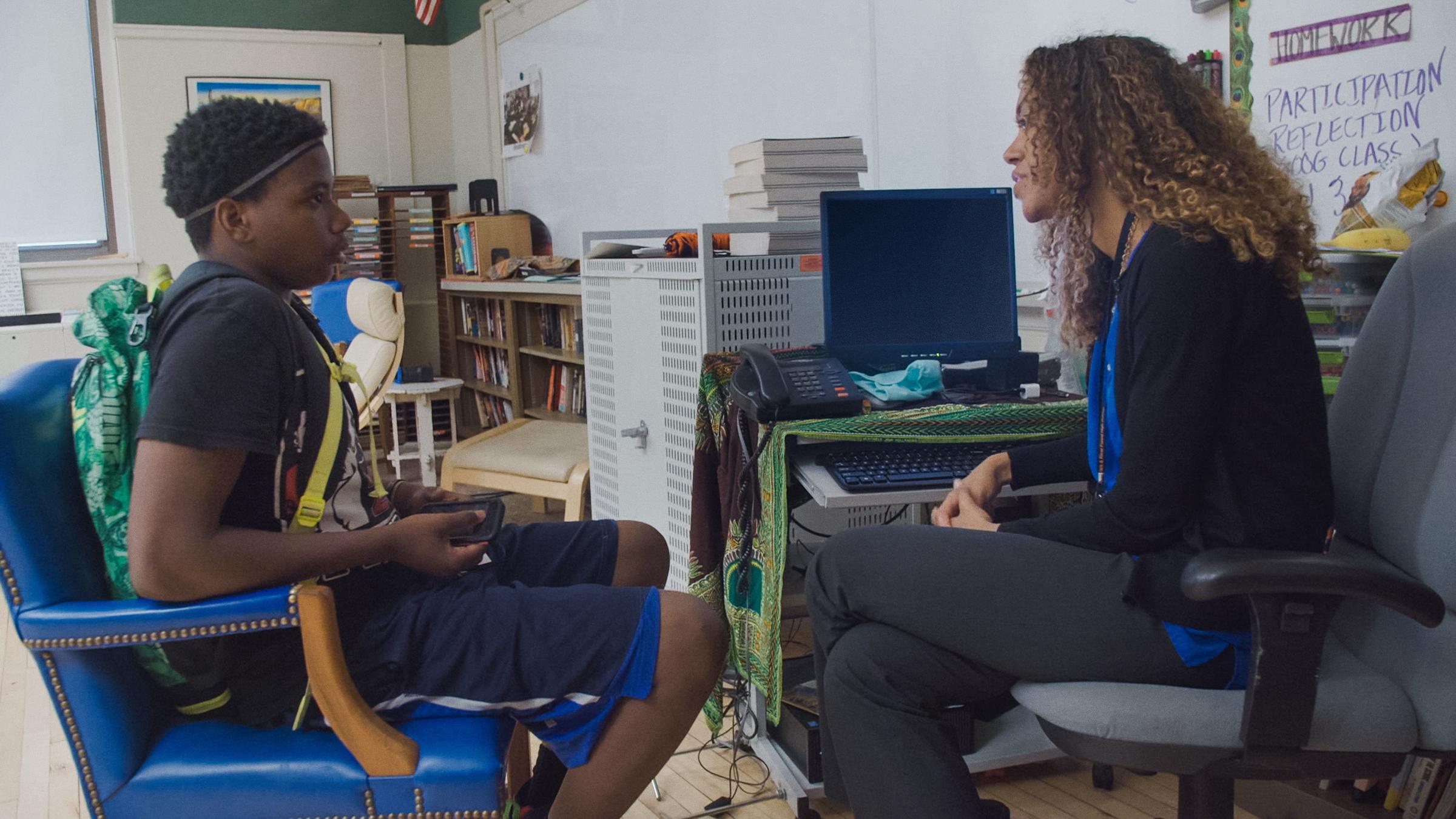
The most eloquent retort to Donald Trump’s favorite slogan—Make America Great Again—was first published in Esquire’s July 1936 issue, a decade before the President’s birth. Though its title is similarly nostalgic, Langston Hughes’ poem “Let America Be America Again” expresses longing for a strikingly different ideal America: a place of equal opportunity and economic justice, where immigrants find freedom from Old World autocrats within a society where Native Americans, Black descendants of slaves and the working class are just as empowered as white Europeans. Yet Hughes laments that this utopia never existed as anything more than a dream. He answers “Let America be America again” with “America never was America to me.”
Considering the phrase’s origin, America to Me may seem like a lofty title for a TV show about a bunch of teenagers. So it’s no small achievement that the frustratingly under-watched 2018 Starz docuseries from creator Steve James (Hoop Dreams, Abacus: Small Enough to Jail) makes such a worthy namesake—and such ideal 4th of July viewing. The filmmaker and his diverse crew spent the 2015-2016 school year, before the most recent Presidential election but after the birth of the Black Lives Matter movement, following roughly a dozen students, their families and a handful of teachers at Oak Park and River Forest High School in Oak Park, Ill. It’s a place whose self-congratulatory, exceptionalist mythology runs as deep as that of America itself. And, as the show illustrates, that ideal Oak Park is not the Oak Park everyone in the district gets to enjoy.
You could surely find compelling stories about race, class and inequality at even the most homogenous American high school. But what makes Oak Park notable, besides the fact that it’s where James lives and sent his own children to public school, is the story the Chicago suburb tells itself about its history of inclusion. A desirable bedroom community thanks in large part to the architectural contributions of famous resident Frank Lloyd Wright and his circle, Oak Park enacted fair-housing measures, as white flight swept the suburbs in the 1960s and ’70s, that attracted progressive residents and led to relatively peaceful, organic integration. By 2015, OPRF’s student population was, as James reports in the series premiere, 55 percent white, 27 percent Black, 9 percent Latinx, 6 percent biracial and 3 percent Asian-American. U.S. News & World Report currently ranks it within the top 5 percent of public high schools in the country, and it exceeds state averages in reading, math and graduation rate. Among its 21st-century alumni are SNL cast member Cecily Strong, NBA star Iman Shumpert and the precocious media mogul turned actor Tavi Gevinson (whose father Steve, a school board member at the time, appears in America to Me).
On paper, OPRF was a rare and resounding success: a very good, very diverse school that seemed to thrive on the inclusive values that the Oak Park community held dear. But, as The Undefeated critic Soraya Nadia McDonald memorably put it in her review of America to Me, an institution that appeared to be a melting pot was “dealing with some serious clumps in its fondue.” In the premiere episode, a chart shows not only a wide gap separating Black and white students’ ACT scores, but also significant improvement among white students over the course of more than a decade, as Black students’ scores, which remained below the state average, barely changed.

While America to Me does follow administrative conflicts throughout the year—largely through the experiences of Jessica Stovall, a young, deeply committed Black English teacher whose efforts to promote equity are too often dismissed by her superiors of all races—its focus is on uncovering the human stories behind the statistics. Mostly (and in no small part because the OPRF principal and district superintendent refused to sit for interviews), that means profiling a smartly selected group of individual students who represent various identities, grades, interests and levels of academic achievement. Kendale, a sweet-natured Black senior, straddles two worlds as both a wrestler and a member of the marching band; his teammate Gabe, also Black, is an all-around star, triumphing in the classroom as well as on the mat. Chanti is a thoughtful biracial junior who uses her work for the spoken word team to explore her evolving gender identity. Diane has divorced lesbian parents and struggles to find her niche as a half-Latinx junior whose peers perceive her as white. Tiara, a Black aspiring pop star who doesn’t hide her lack of interest in school, lives with her much older sister Telicia, a devoted mom who spends much of her time advocating at OPRF for her own differently abled 17-year-old son, Terrence.
The series spotlights just two members of the school’s white majority: overachieving freshman Caroline and Brendan, a preternaturally chill sophomore baseball player, both of whom joined the project midway through the year. This, too, was less a choice than the result of white kids’ and their families’ reluctance to participate in a documentary they, tellingly, seemed to fear would reveal their unfair advantages. At one point, Caroline mentions overhearing another white girl opine that students like her would simply be cast as representatives of white privilege. In fact, James renders every character in three dimensions. Among the kids, at least, there are no villains. I felt for Caroline when the pressure she puts on herself leads to anxiety attacks, just as I felt for Jada, an equally bright Black senior with an interest in filmmaking and social justice, when a white, male teacher picks a fight with her over a viral video where a Black teen girl confronts a white classmate about cultural appropriation. The difference is structural. Caroline’s problem stems from her own sense that she should be the best student at OPRF; Jada’s is that the antiracist beliefs she so intelligently expresses intimidate a white man in a position of power.
As it turns out, the show’s at least partly unintentional overrepresentation of Black and biracial students functions as an antidote to an educational system—and a larger society—where white kids are treated as individuals while their counterparts of color are too often seen as faceless statistics. Every teen has something they’re passionate about; an adorably green freshman, Grant, finds his people among the theater crowd, while Diane was once the only girl on the football team. Beyond race, they teens break the binaries of jock and brain, teacher’s pet and rebel, male and female. Their families come in all shapes and sizes, though a common thread is parents and guardians who make huge sacrifices to send their children to a supposedly great school that often fails those who need its resources the most. Because we immediately see the best in these students, through the lenses of James and segment directors Bing Liu (the young filmmaker behind 2019’s remarkable Minding the Gap), Kevin Shaw (The Street Stops Here) and Rebecca Parrish (Radical Grace), it comes as a relief when their cameras capture an adult nurturing those qualities—as Stovall does with charming, sometimes disengaged junior Ke’Shawn.

Form serves content in this absorbing series, so much so that it was only upon a recent second viewing that I appreciated how elegantly America to Me moves from subject to subject, teen to adult, daily routine to special events like spoken word competitions and dances, classroom to cafeteria to extracurriculars to home. It’s through masterly storytelling, not heavy-handed editorializing, that James (whose occasional voiceover narration provides context without telling viewers what to think) connects the personal with the systemic. In following Tiara to a football game, we see how her mostly Black cheerleading squad is pushed to the side of the stadium while the mostly white girls on the drill team get prime placement. When a white science teacher reflects, “I feel a kind of natural connection with my AP students, because that’s the kind of kid I was,” we sense how that kind of attitude can reinforce an existing achievement gap.
James is not prescriptive, but by the end of 10 episodes, the show makes it hard to believe that anything short of radical, bone-deep change can make OPRF live up to its noble ideals. The implications are clear for the national public education system of which it is a microcosm as well as for an American culture manufactured, in large part, by schools. Soon after America to Me aired, a heightened awareness of race at OPRF triggered multiple acts of white-supremacist retaliation within the building, including hateful graffiti. Those outbursts, in turn, fueled demands for changes to the school’s disciplinary policies, more teachers of color and mandatory Black history classes for all students.
Both the show and its immediate aftermath reverberate loudly more than a month into the latest in a wave of worldwide uprisings against racism and inequality. Administrators “have a big task ahead of themselves in turning such a large school in new directions,” James noted in an interview shortly after the show ended its run, “especially when it presently works so well for a majority of the white and wealthier families in the community.” You could say the same for such a large country. Yet in the case of America as well as Oak Park, the overdue reckonings provide reason enough to persevere. “America never was America to me,” Hughes resolves near the end of his poem. “And yet I swear this oath—/America will be!”
Update, July 6: Participant Media, one of the production companies behind America to Me, has put together episode-by-episode discussion guides for the show. Educators can register here for free access to the full docuseries.
More Must-Reads From TIME
- The 100 Most Influential People of 2024
- Coco Gauff Is Playing for Herself Now
- Scenes From Pro-Palestinian Encampments Across U.S. Universities
- 6 Compliments That Land Every Time
- If You're Dating Right Now , You're Brave: Column
- The AI That Could Heal a Divided Internet
- Fallout Is a Brilliant Model for the Future of Video Game Adaptations
- Want Weekly Recs on What to Watch, Read, and More? Sign Up for Worth Your Time
Contact us at letters@time.com